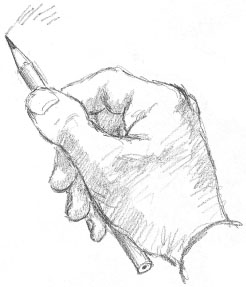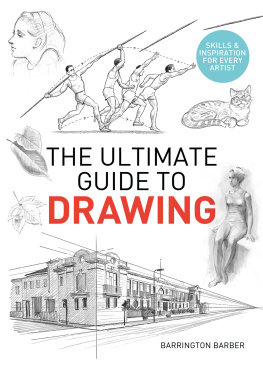
INTRODUCTION
Its not uncommon to hear people saying they would like to try their hand at art, adding, But I cant draw, as if this were an immutable fact that rules them out from the start. Yet being able to draw isnt a rare and special quality. It does help if you have some innate talent, of course, but that isnt the main thing; in my long career as an art teacher Ive often seen students with talent but not much will to work overtaken by much less naturally gifted students who were prepared to put in the groundwork and persevere. Ive taught people from five years of age to 70 and have never come across anyone I couldnt teach to draw adequately if they really wanted to learn. So the first step is to feel confident that its only a matter of how much work you are prepared to put into drawing that decides how well you will do, and that confidence will carry you through the small failures that occur whenever you try to learn a new skill.
This book follows a particular plan that has been designed to make the learning process easier for you. It begins by describing the most useful mediums for a beginner before moving on to the basics of line drawing, which is the simplest and most obvious method of drawing.
Once you have gained some proficiency with that you will then tackle the use of tone and texture in order to flesh out your line drawings and make them look three-dimensional.
Theres also a section on observation, which is the most important thing for an artist to practise; after all, you cant draw something accurately if you havent really absorbed what it looks like in life. Accuracy in drawing the human figure is particularly important, because our familiarity with it means that mistakes in proportion are easily spotted. From this book youll learn the classic proportions, so that if you do need to diverge from them to show an individuals particular characteristics you will be able to do so convincingly many of us, lets face it, dont fit the classical norm. Youll also find a section on perspective that will help you to assess how to draw larger objects such as buildings without being too intimidated by the size and complexity of their structure.
Next, the composition of your picture is a useful thing to consider, although you may not want to think about this until youve been drawing for a while. However, to make your drawings work on a formal scale some understanding of how to compose a picture will enhance your artistic skill.
Finally, well look at some useful practices that all artists need to know in order to improve their ability. Learning to draw on the move, for instance, enables an artist to act on impulse and forces them to respond creatively to different situations. The great thing about drawing is that theres always another skill or sensitivity that you can add to your repertoire as an artist, and thats one of the things that keep artists working happily until their later years.

SUBJECT MATTER
In this book well look at all types of subject matter that you can tackle as you build up your skills. The easiest things to draw are simple everyday and still-life objects because you can arrange them as you like and they stay still. Some more complex objects, such as musical instruments, are next in line of difficulty; after that come plants and, when you have mastered those, the whole landscape, where you have to cope with the light constantly changing and every breath of wind moving the vegetation and the clouds.


Animals are tricky to draw because they rarely keep still and generally have no inclination to do what you want. Youll often have to take photographs to work from in order to become more familiar with their shapes.
When it comes to humans, for a portrait drawing you do have the advantage that the model probably wants to be drawn well and will pose for you but we pick up many subtle distinctions in the human face, and if you miss them out it reduces the likeness of the portrait. It takes a while to achieve portraits that are convincing, showing not only the features realistically but also the persons character.
Probably the hardest subject matter for drawing is the human body as a whole. Its so complex that I believe even the most accomplished artists never achieve perfection in their works, so dont worry too much if your first attempts arent great works of art. Drawing groups of figures is even more complex both in terms of composition and keeping an eye on the finer details but the challenges are very satisfying as well. Keep practising, using the exercises here and as soon as you have a little success youll begin to see why artists find it impossible to stop drawing, once they have started.
THE BASICS
When you start to draw you need to know a few basics about how to handle your equipment and draw to size. Later you will begin to develop a personal style of working with which you feel comfortable.
HOLDING A PENCIL
You may think advice on how to hold a pencil seems rather unnecessary, but I assure you that an artist must learn how to handle the instruments of drawing properly in order to get the best results. You dont have to grasp the pencil in a vice-like grip, which its easy to do without being aware of it if youre feeling a bit tense about tackling something difficult. Hold it loosely, so that you can manoeuvre it easily. Then practise different ways of handling it, as shown.

Hold your pencil as you would a stick, with your thumb on top, and see how well you can control your strokes. Dont grip it tightly. This method is ideal for drawing at an easel with the drawing board upright.

Then hold the pencil as you might usually hold it for writing, but again without gripping it tightly. Keep altering the way that you hold the pencil until you feel comfortable with different methods.
THE ANGLE OF THE PAPER
When you draw with the paper flat on a table-top, its very easy to make distorted drawings because of the angle at which you see the surface. Ideally you should have the surface of the paper at right angles to your eyeline, so that you are always looking at the drawing centre on, which will eradicate accidental distortion.
Although most artists do find the best method is to use an easel, this is not necessary you can simply tilt the paper on the edge of a table so that you can comfortably look directly at the surface.

SIZING YOUR DRAWING
Its all too easy to fall into the habit of always drawing your subjects at the same size. This rather limits your ability to improve, as an artist should be able to draw at any size that is needed.
Next page




















